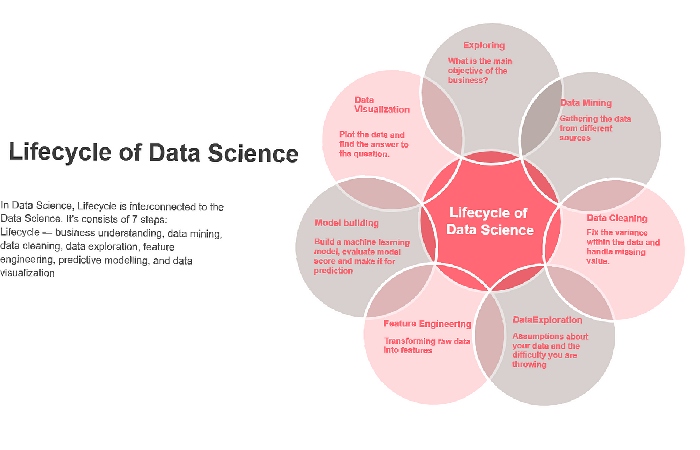Over time, the landscape of data science has evolved. First coined in the late 1990s to describe collecting and cleaning datasets, it now encompasses a broad spectrum, including data analysis, predictive analytics, data mining, and machine learning. To simplify, it involves acquiring, organizing, and digitizing information for informed decision-making. Once data is structured, analysis, dashboards, and reports enhance understanding of company performance. Progressing, predictive analytics anticipates future scenarios and consumer behavior. As we grasp the fundamentals, exploring the latest methods becomes imperative.
The importance of data science techniques lies in their capability to extract meaningful insights from vast datasets, driving informed decision-making across various domains. A data science PG course is a transformative pathway to excel in this field. It equips individuals with advanced data analytics, machine learning, and statistical modeling skills. Through real-world applications and hands-on projects, students gain practical experience, honing their abilities to solve complex problems. Additionally, a structured curriculum keeps learners abreast of the latest advancements, ensuring they stay relevant in the rapidly evolving field of data science. Overall, a data science postgraduate course is a catalyst for career growth, empowering individuals to navigate and excel in the dynamic landscape of data-driven decision-making.

Table of Contents
What is Data Science?
Data science refers to extracting meaningful insights from vast datasets through advanced analytics, machine learning, and statistical modeling. It comprises the entire data lifecycle, from acquisition and cleaning to analysis and interpretation. Data scientists uncover patterns, trends, and correlations by employing diverse techniques, aiding informed decision-making in various industries. The interdisciplinary nature of data science combines expertise in mathematics, computer science, and domain-specific knowledge. It is pivotal in transforming raw data into actionable intelligence, driving innovation, optimizing processes, and addressing complex challenges in an increasingly data-driven world.
Data Science Techniques
Data science techniques encompass a range of methodologies for extracting valuable insights from data. They include statistical analysis, machine learning algorithms, data mining, and predictive modeling. Techniques involve cleaning and organizing data, exploratory data analysis, and applying algorithms to uncover patterns and trends. Visualization tools and statistical programming languages aid in interpreting results. The goal is to transform raw/unstructured data into actionable intelligence, supporting informed decision-making across various domains.
Top Data Science Techniques
Regression:
In data science, regression is a statistical method employed to depict the connection between a dependent and one or more independent variables. It aims to predict the dependent variable’s value based on the independent variables’ values, helping identify patterns and trends in data.
Classification:
Classification, a crucial data science technique, involves categorizing data into predefined classes based on features. It employs machine learning algorithms to learn patterns from labeled datasets, enabling the model to predict the new, unseen data class. Widely used in diverse applications such as spam detection, image recognition, and medical diagnosis, classification aids in making informed decisions. By training on historical data, the model learns to generalize and classify future instances accurately. This technique enhances automation, streamlines processes, and contributes to predictive analytics, fostering efficiency and accuracy in solving classification problems across various industries.
Personalization:
In data science, personalization is a method that customizes content, suggestions, or services for individual users by considering their preferences, behavior, and historical data. Utilizing machine learning algorithms, it analyzes user interactions to provide a tailored experience, ultimately elevating user satisfaction and engagement.
Anomaly detection:
Anomaly detection in data science involves identifying patterns or instances that deviate significantly from the norm within a dataset. Utilizing statistical methods or machine learning algorithms, helps detect unusual behaviors or outliers, aiding in fraud detection, fault diagnosis, and quality control.
Lift analysis:
Lift analysis in data science assesses the effectiveness of a predictive model by comparing its performance against a baseline model. It measures the improvement in targeting or prediction accuracy, helping evaluate the value added by the model in making informed decisions or predictions.
Jackknife regression:
Jackknife regression in data science is a resampling technique where multiple models are fitted, each excluding one observation. It assesses the stability and reliability of a regression model, providing insights into its performance and identifying potential outliers or influential data points.
Game Theory:
It is a mathematical framework for modeling strategic interactions between rational decision-makers. It analyzes outcomes, strategies, and payoffs to predict how individuals or entities behave in competitive situations, aiding decision-making in economics, business, and social sciences.
Decision Tree:
It is a visual representation of decision-making processes, illustrating choices, outcomes, and probabilities. It helps in complex decision analysis by mapping various scenarios, making it a valuable tool in data science, machine learning, and business strategy for evaluating options and predicting potential outcomes.
Skills Required for a Data Science Career
A successful data science career demands a multifaceted skill set. First and foremost, proficiency in programming languages like Python and R is essential for data manipulation and analysis. Statistical knowledge, encompassing hypothesis testing and regression analysis, enables meaningful interpretation of data. Expertise in machine learning techniques, such as classification and regression algorithms, is crucial for predictive modeling. Data visualization skills, efficiency in using tools like Tableau or Matplotlib, aid in communicating findings effectively. Strong domain knowledge in the industry of application is invaluable for contextual insights.
Moreover, data engineer skills involving data cleaning and preprocessing and familiarity with big data technologies like Hadoop or Spark enhance the ability to handle large datasets. Strong communication skills, both technical and non-technical, are vital for conveying complex insights to diverse stakeholders. Continuous learning and adaptability are imperative in the ever-evolving field of data science, making staying abreast of emerging technologies and methodologies an ongoing requirement for a thriving career.
Conclusion
Mastering top data science techniques is pivotal for a successful data science career. From regression to machine learning, these skills empower professionals to extract insights and drive informed decisions. Pursuing a data science PG course enhances expertise, offering hands-on experience and knowledge alignment with industry demands. Acquiring these skills broadens career prospects and equips individuals to navigate the dynamic landscape of data science, ensuring readiness for impactful contributions in a competitive job market. Invest in a data science PG course to secure a promising and fulfilling data science career.
Related posts
Featured Posts
Creating Professional Quotes and Estimates for Small Businesses
A Step-by-Step Guide to Creating Professional Quotes and Estimates for Small Businesses- Inaccurate quotes can potentially cost you more than…
Tasha k Net Worth – Assets, Growth, and More
Tasha k Net Worth You may check this page for Tasha K’s net worth, profile, age, boyfriend, height, weight, and…




